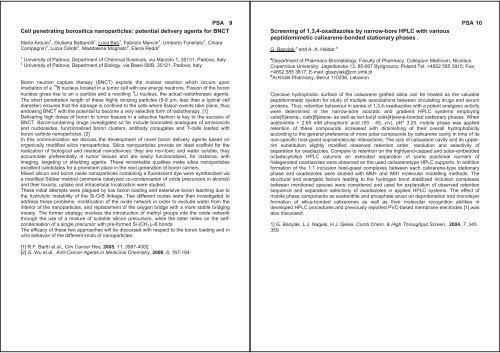ISMSC 2007 - Università degli Studi di Pavia
ISMSC 2007 - Università degli Studi di Pavia
ISMSC 2007 - Università degli Studi di Pavia
Create successful ePaper yourself
Turn your PDF publications into a flip-book with our unique Google optimized e-Paper software.
PSA 9<br />
Cell penetrating borosilica nanoparticles: potential delivery agents for BNCT<br />
Maria Arduini 1 , Giuliana Battanolli 1 , Luca Baù 1 , Fabrizio Mancin 1 , Umberto Tonellato 1 , Chiara<br />
Compagnin 2 , Lucia Celotti 2 , Maddalena Mognato 2 , Elena Red<strong>di</strong> 2<br />
1 University of Padova, Department of Chemical Sciences, via Marzolo 1, 35131, Padova, Italy<br />
2 University of Padova, Department of Biology, via Bassi 58/B, 35121, Padova, Italy<br />
Boron neutron capture therapy (BNCT) exploits the nuclear reaction which occurs upon<br />
irra<strong>di</strong>ation of a 10 B nucleus located in a tumor cell with low energy neutrons. Fission of the boron<br />
nucleus gives rise to an α particle and a recoiling 7 Li nucleus, the actual ra<strong>di</strong>otherapic agents.<br />
The short penetration length of these highly ionizing particles (5-9 µm, less than a typical cell<br />
<strong>di</strong>ameter) ensures that the damage is confined to the cells where fission events take place, thus<br />
endowing BNCT with the potential to become a very selective form of ra<strong>di</strong>otherapy. [1]<br />
Delivering high doses of boron to tumor tissues in a selective fashion is key to the success of<br />
BNCT. Boron-containing drugs investigated so far include boronated analogues of aminoacids<br />
and nucleosides, functionalized boron clusters, antibody conjugates and T-cells loaded with<br />
boron carbide nanoparticles. [2]<br />
In this communication we <strong>di</strong>scuss the development of novel boron delivery agents based on<br />
organically mo<strong>di</strong>fied silica nanoparticles. Silica nanoparticles provide an ideal scaffold for the<br />
realization of biological and me<strong>di</strong>cal nanodevices: they are non-toxic and water soluble, they<br />
accumulate preferentially in tumor tissues and are easily functionalized, for instance, with<br />
imaging, targeting or shiel<strong>di</strong>ng agents. These remarkable qualities make silica nanoparticles<br />
excellent can<strong>di</strong>dates for a prominent place in the next generation of boron carriers.<br />
Mixed silicon and boron oxide nanoparticles containing a fluorescent dye were synthesized via<br />
a mo<strong>di</strong>fied Stöber method (ammonia catalyzed co-condensation of oxide precursors in alcohol)<br />
and their toxicity, uptake and intracellular localization were stu<strong>di</strong>ed.<br />
These initial attempts were plagued by low boron loa<strong>di</strong>ng and extensive boron leaching due to<br />
the hydrolytic instability of the Si-O-B linkage. Two <strong>di</strong>fferent routes were then investigated to<br />
address these problems: mo<strong>di</strong>fication of the oxide network in order to exclude water from the<br />
interior of the nanoparticles, and replacement of the oxygen bridge with a more stable bridging<br />
moiety. The former strategy involves the introduction of methyl groups into the oxide network<br />
through the use of a mixture of suitable silicon precursors, while the latter relies on the selfcondensation<br />
of a single precursor with pre-formed Si-(CH2)2-B bonds.<br />
The efficacy of these two approaches will be <strong>di</strong>scussed with respect to the boron loa<strong>di</strong>ng and in<br />
vitro behavior of the <strong>di</strong>fferent kinds of nanoparticles.<br />
[1] R.F. Barth et al., Clin Cancer Res, 2005, 11, 3987-4002<br />
[2] G. Wu et al., Anti-Cancer Agents in Me<strong>di</strong>cinal Chemistry, 2006, 6, 167-184<br />
Screening of 1,3,4-oxa<strong>di</strong>azoles by narrow-bore HPLC with various<br />
peptidomimetic calixarene-bonded stationary phases .<br />
G. Bazylak a and A. A. Haidar b<br />
PSA 10<br />
a Department of Pharmaco-Bromatology, Faculty of Pharmacy, Collegium Me<strong>di</strong>cum, Nicolaus<br />
Copernicus University, Jagiellonska 13, 85-067 Bydgoszcz, Poland Tel: +4852 585 3915; Fax:<br />
+4852 585 3817; E-mail: gbazylak@cm.umk.pl<br />
b Al Khalil Pharmacy, Beirut 110236, Lebanon<br />
Concave hydrophobic surface of the calixarene grafted silica can be treated as the valuable<br />
peptidomimetic system for study of multiple associations between circulating drugs and serum<br />
proteins. Thus, retention behaviour in series of 1,3,4-oxa<strong>di</strong>azoles with a potent analgesic activity<br />
were determined in the narrow-bore isocratic and gra<strong>di</strong>ent HPLC systems employing<br />
calix[6]arene-, calix[8]arene- as well as tert-butyl calix[4]arene-bonded stationary phases. When<br />
acetonitrile + 2.65 mM phosphoric acid (55 : 45, v/v), pH* 3.25, mobile phase was applied<br />
retention of these compounds increased with <strong>di</strong>minishing of their overall hydrophobicity<br />
accor<strong>di</strong>ng to the general preference of more polar compounds by calixarene cavity in time of its<br />
non-specific host-guest supramolecular interactions. The size of calixarene cavity and its upperrim<br />
substitution slightly mo<strong>di</strong>fied observed retention order, resolution and selectivity of<br />
separation for oxa<strong>di</strong>azoles. Compare to retention on the highlyend-capped and polar-embedded<br />
octadecylsilica HPLC columns an extended separation of some positional isomers of<br />
halogenated oxa<strong>di</strong>azoles were observed on the used calixarenetype HPLC supports. In ad<strong>di</strong>tion<br />
formation of the 1:1 inclusion host-guest complexes between each calixarene-type stationary<br />
phase and oxa<strong>di</strong>azoles were stu<strong>di</strong>ed with MM+ and AM1 molecular modelling methods. The<br />
structural and energetic factors lea<strong>di</strong>ng to the hydrogen bond stabilized inclusion complexes<br />
between mentioned species were considered and used for explanation of observed retention<br />
sequence and separation selectivity of oxa<strong>di</strong>azoles in applied HPLC systems. The effect of<br />
mobile phase components as acetonitrile and phosphate anion on deprotonation and monolayer<br />
formation of silica-bonded calixarenes as well as their molecular recognition abilities in<br />
developed HPLC procedures and previously reported PVC-based membrane electrodes [1] was<br />
also <strong>di</strong>scussed.<br />
1] G. Bazylak, L.J. Nagels, H.J. Geise, Comb.Chem. & High Throughput Screen., 2004, 7, 345 .<br />
359

















